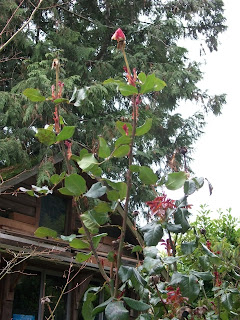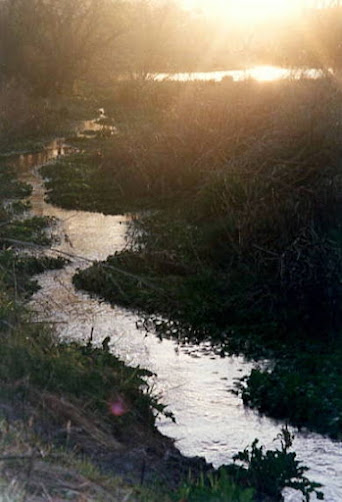The Northwest Garden in March
 |
| One of my favorite northwest plants: Mahonia nervosa (Low Oregon Grape), with its emerging flower bud in my former Seattle garden |
 |
| Chives shoots |
Ornamental Gardening Tips for March:
1. Plant bare root shrubs
They are so much less expensive than containerized or ball & burlap plants, because you are not paying for the soil, nursery container, and shipping weight. You will also have an easier time planting them at the correct soil height, because you can see the entire root system at the start.
To give you an idea of the savings, a few years ago I bought 100 plants from King Conservation District for the Magnuson Community Center Resource Conservation Landscape project- 40 Tall Oregon Grape and 60 Low Oregon Grape- for $150.00. Their sale is a once-a-year event, but many good local nurseries also carry bare root trees and shrubs during this time of year, and their deals will amaze you too. One word of caution: because these plants are not in soil, they need to either be planted as soon as you get them home, or "heeled in" temporarily until you are ready to plant them in a permanent location.
 |
| Rosa 'Voodo' (Hybrid Tea) |
Now is the time to prune your hybrid tea roses, floribundas, and climbers. Also, make sure to remove all of last year's leaves if they didn't fall off in the winter, which will help prevent black spot or other fungal spores from being transmitted to this year's new shoots.
Old-fashioned shrub roses need little or no pruning, and most climbers benefit by pruning only the side branches and not the main canes, but Hybrid Tea Roses typically bloom best when the main canes are pruned to 18-36 inches from the ground. It might seem like harsh treatment, but Hybrid Tea Roses will grow stronger canes and more flowers if you do this. A good example in my former Seattle garden is the 'Voodoo' Rose (photo at right) which grew to be 6-8 ft tall every year even though I pruned it back to 2-3 ft each March. A good rule of thumb for pruning the smaller side canes is to shorten them according to diameter: the smaller they are, the shorter they should be cut. Those that are pencil-size or less should be removed completely. Thinning out branches that cross through the middle of the shrub helps promote good air circulation, and helps prevent fungal diseases from gaining a foothold.
Not all roses are pruned the same though, so it's important to vary your method according to whether you have a Hybrid Tea, a Floribunda, or a Climbing or Rambling Rose. The best online resource in the world to learn how to prune anything, including every kind of rose, is the Plant Amnesty YouTube channel- check it out!
 |
| Clematis armandii (Evergreen Clematis) flower buds and new shoots |
 |
Clematis x jouiniana leaf buds emerging |
New shoots are emerging from many types of Clematis varieties now, but there are different pruning methods for different species, and some need almost no pruning ever.
For instance, the Clematis armandii (above left) sends out long and vigorous new vines from its woody, tree-like main structure at the same time that its sweet-blooming flower clusters open. Because in my former Seattle garden there was a huge lath-house roof over the deck for it to sprawl on, it was only necessary to prune back the new vines if/when they started growing over into it's neighbor, the deciduous Clematis x jouinania (above right). The jouiniana has a woody-tree-like structure also, but is super easy to make pruning decisions about. The tip of each vine typically dies back during winter, so all that's needed is to look for the top-most emerging leaf buds and then prune off everything above them. Other Clematis species are pruned by being thinned more delicately here and there, or by cutting all vines to the base. A lot of the info out there in books and websites is overly complex and hard to figure out, especially if you can't remember which species you have and/or you've lost the plant tag.... so once again, my advice is to check out the Plant Amnesty YouTube channel!
Edible Gardening Tips for March:
 1. Start planting
cool-crop seeds
1. Start planting
cool-crop seedsMy spring favorites are lettuce, spinach, chard, kale, carrots, radishes, beets, and the all-important snap peas (you can even eat their twining tendrils when young and tender).
Root crops should always be direct-seeded into your garden soil because they won't thrive if transplanted, but I like to plant my peas and greens in small pots, with the warmth of my refrigerator top or kitchen table providing a quick-start to their germination. When they are big enough to plant outside, all potted starts need to be "hardened off" little by little before being planted in your garden, so they don't suffer transplant shock. Check out this cool GrowVeg.com website to see the step-by-step way to harden off your plants, and many other good tips!
 |
| A thriving Pumpkin plant |
Your vegetable plants will thrive, and be more pest and disease resistant, when the soil they are growing in is healthy too. Most veggies tend to be "heavy feeders", needing more nutrients and water than ornamental plants. The best way to ensure that both those things will be available to them throughout the growing season is to incorporate a 2-3" layer of compost into your veggie beds each year before planting. Compost is a wonder: it helps sandy soils hold onto summer irrigation water and fertilizer, and helps loosen clay soils so they allow nutrients to be released and also drain better. For some extra TLC, add a 1" layer of compost as a top-dressing after your plants are a few inches high. If you have a drip irrigation system, covering the lines with compost will also help prevent UV damage to them so they last longer!



